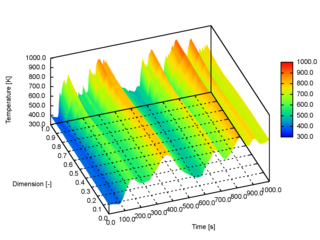
Combustion, or burning, is a high-temperature exothermic redox chemical reaction between a fuel and an oxidant, usually atmospheric oxygen, that produces oxidized, often gaseous products, in a mixture termed as smoke. Combustion in a fire produces a flame, and the heat produced can make combustion self-sustaining. Combustion is often a complicated sequence of elementary radical reactions. Solid fuels, such as wood and coal, first undergo endothermic pyrolysis to produce gaseous fuels whose combustion then supplies the heat required to produce more of them. Combustion is often hot enough that incandescent light in the form of either glowing or a flame is produced. A simple example can be seen in the combustion of hydrogen and oxygen into water vapor, a reaction commonly used to fuel rocket engines. This reaction releases 242 kJ/mol of heat and reduces the enthalpy accordingly :

Thermal radiation is electromagnetic radiation generated by the thermal motion of particles in matter. All matter with a temperature greater than absolute zero emits thermal radiation. Particle motion results in charge-acceleration or dipole oscillation which produces electromagnetic radiation.

A flame is the visible, gaseous part of a fire. It is caused by a highly exothermic reaction taking place in a thin zone. Very hot flames are hot enough to have ionized gaseous components of sufficient density to be considered plasma.

Computational fluid dynamics (CFD) is a branch of fluid mechanics that uses numerical analysis and data structures to analyze and solve problems that involve fluid flows. Computers are used to perform the calculations required to simulate the free-stream flow of the fluid, and the interaction of the fluid with surfaces defined by boundary conditions. With high-speed supercomputers, better solutions can be achieved, and are often required to solve the largest and most complex problems. Ongoing research yields software that improves the accuracy and speed of complex simulation scenarios such as transonic or turbulent flows. Initial validation of such software is typically performed using experimental apparatus such as wind tunnels. In addition, previously performed analytical or empirical analysis of a particular problem can be used for comparison. A final validation is often performed using full-scale testing, such as flight tests.
Turbulence modeling is the construction and use of a mathematical model to predict the effects of turbulence. Turbulent flows are commonplace in most real life scenarios, including the flow of blood through the cardiovascular system, the airflow over an aircraft wing, the re-entry of space vehicles, besides others. In spite of decades of research, there is no analytical theory to predict the evolution of these turbulent flows. The equations governing turbulent flows can only be solved directly for simple cases of flow. For most real life turbulent flows, CFD simulations use turbulent models to predict the evolution of turbulence. These turbulence models are simplified constitutive equations that predict the statistical evolution of turbulent flows.
Lattice Boltzmann methods (LBM) is a class of computational fluid dynamics (CFD) methods for fluid simulation. Instead of solving the Navier–Stokes equations, the discrete Boltzmann equation is solved to simulate the flow of a Newtonian fluid with collision models such as Bhatnagar–Gross–Krook (BGK). By simulating streaming and collision processes across a limited number of particles, the intrinsic particle interactions evince a microcosm of viscous flow behavior applicable across the greater mass.
In fluid dynamics, turbulence kinetic energy (TKE) is the mean kinetic energy per unit mass associated with eddies in turbulent flow. Physically, the turbulence kinetic energy is characterised by measured root-mean-square (RMS) velocity fluctuations.
Dudley Brian Spalding, FRS FREng was Professor of Heat Transfer and Head of the Computational Fluid Dynamics Unit at Imperial College, London. He was one of the founders of computational fluid dynamics (CFD) and an internationally recognized contributor to the fields of heat transfer, fluid mechanics and combustion. He created the practice of CFD – its application to problems of interest to engineers. Most of today’s commercially available CFD software tools trace their origin to the work done by Spalding's group in the decade spanning the mid-60s and mid-70s. Spalding became a Fellow of the Royal Society and Fellow of the Royal Academy of Engineering.
The surface of the Sun radiates light and heat at approximately 5,500 °C. The Earth is much cooler and so radiates heat back away from itself at much longer wavelengths, mostly in the infrared range. The idealized greenhouse model is based on the fact that certain gases in the Earth's atmosphere, including carbon dioxide and water vapour, are transparent to the high-frequency, high-energy solar radiation, but are much more opaque to the lower frequency infrared radiation leaving the surface of the earth. Thus heat is easily let in, but is partially trapped by these gases as it tries to leave. Rather than get hotter and hotter, Kirchhoff's law of thermal radiation says that the gases of the atmosphere also have to re-emit the infrared energy that they absorb, and they do so, also at long infrared wavelengths, both upwards into space as well as downwards back towards the Earth's surface. In the long-term, thermal equilibrium is reached when all the heat energy arriving on the planet is leaving again at the same rate. In this idealized model, the greenhouse gases cause the surface of the planet to be warmer than it would be without them, in order for the required amount of heat energy finally to be radiated out into space from the top of the atmosphere.
Tasneem Mohammad Shah, SI, TI, is a Pakistani scientist and a prominent mathematician who has made pioneering and instrumental research and contributions to the field of computational fluid dynamics (CFD) at Dr. A. Q. Khan Research Laboratories (KRL). Trained as an applied mathematician, his contributions include differential geometry, numerical analysis, information security, CFD-DEM model, hydrodynamics, computer science, fluid mechanics, Vacuum Technology and CFD-DEM.
The Gebhart factors are used in radiative heat transfer, it is a means to describe the ratio of radiation absorbed by any other surface versus the total emitted radiation from given surface. As such, it becomes the radiation exchange factor between a number of surfaces. The Gebhart factors calculation method is supported in several radiation heat transfer tools, such as TMG and TRNSYS.
The multiphase particle-in-cell method (MP-PIC) is a numerical method for modeling particle-fluid and particle-particle interactions in a computational fluid dynamics (CFD) calculation. The MP-PIC method achieves greater stability than its particle-in-cell predecessor by simultaneously treating the solid particles as computational particles and as a continuum. In the MP-PIC approach, the particle properties are mapped from the Lagrangian coordinates to an Eulerian grid through the use of interpolation functions. After evaluation of the continuum derivative terms, the particle properties are mapped back to the individual particles. This method has proven to be stable in dense particle flows, computationally efficient, and physically accurate. This has allowed the MP-PIC method to be used as particle-flow solver for the simulation of industrial-scale chemical processes involving particle-fluid flows.

KIVA is a family of Fortran-based Computational Fluid Dynamics software developed by Los Alamos National Laboratory (LANL). The software predicts complex fuel and air flows as well as ignition, combustion, and pollutant-formation processes in engines. The KIVA models have been used to understand combustion chemistry processes, such as auto-ignition of fuels, and to optimize diesel engines for high efficiency and low emissions. General Motors has used KIVA in the development of direct-injection, stratified charge gasoline engines as well as the fast burn, homogeneous-charge gasoline engine. Cummins reduced development time and cost by 10%–15% using KIVA to develop its high-efficiency 2007 ISB 6.7-L diesel engine that was able to meet 2010 emission standards in 2007. At the same time, the company realized a more robust design and improved fuel economy while meeting all environmental and customer constraints.

The extended discrete element method (XDEM) is a numerical technique that extends the dynamics of granular material or particles as described through the classical discrete element method (DEM) by additional properties such as the thermodynamic state, stress/strain or electro-magnetic field for each particle. Contrary to a continuum mechanics concept, the XDEM aims at resolving the particulate phase with its various processes attached to the particles. While the discrete element method predicts position and orientation in space and time for each particle, the extended discrete element method additionally estimates properties such as internal temperature and/or species distribution or mechanical impact with structures.
CFD stands for computational fluid dynamics. As per this technique, the governing differential equations of a flow system or thermal system are known in the form of Navier–Stokes equations, thermal energy equation and species equation with an appropriate equation of state. In the past few years, CFD has been playing an increasingly important role in building design, following its continuing development for over a quarter of a century. The information provided by CFD can be used to analyse the impact of building exhausts to the environment, to predict smoke and fire risks in buildings, to quantify indoor environment quality, and to design natural ventilation systems.
The eddy break-up model (EBU) is used in combustion engineering.
Combustion modeling has a wide range of applications. In most of the combustion systems fuel and oxygen are separately supplied in the combustion chamber. Due to this chemical reaction and combustion occurs simultaneously in the combustion chamber. However, the rate of the chemical reaction is faster than the rate of mixing fuel and oxygen. Therefore, that rate of combustion is controlled by rate of mixing. Such cases, where formation of pre-mixture is difficult, are called diffusion combustion or diffusion flames.
Combustion models for CFD refers to combustion models for computational fluid dynamics.
Combustion is defined as a chemical reaction in which a hydrocarbon fuel reacts with an oxidant to form products, accompanied with the release of energy in the form of heat. Being the integral part of various engineering applications like: internal combustion engines, aircraft engines, rocket engines, furnaces, and power station combustors, combustion manifests itself as a wide domain during the design, analysis and performance characteristics stages of the above-mentioned applications. With the added complexity of chemical kinetics and achieving reacting flow mixture environment, proper modeling physics has to be incorporated during computational fluid dynamic (CFD) simulations of combustion. Hence the following discussion presents a general outline of the various adequate models incorporated with the Computational fluid dynamic code to model the process of combustion.
K-epsilon (k-ε) turbulence model is the most common model used in Computational Fluid Dynamics (CFD) to simulate mean flow characteristics for turbulent flow conditions. It is a two equation model that gives a general description of turbulence by means of two transport equations (PDEs). The original impetus for the K-epsilon model was to improve the mixing-length model, as well as to find an alternative to algebraically prescribing turbulent length scales in moderate to high complexity flows.
The laminar flamelet model is one of the methods of modelling turbulent combustions apart from SCRS, eddy flamelet model and others. Combustion is a very important thermochemical process with significant material and aerodynamic implications and thus CFD modeling of combustion has become indispensable. The laminar flamelet model is basically for non pre-mixed fuel.
Computational fluid dynamics (CFD) are used to understand complex thermal flow regimes in power plants. The thermal power plant may be divided into different subsectors and the CFD analysis applied to critical equipment/components - mainly different types of heat exchangers - which are of crucial significance for efficient and trouble free long-term operation of the plant.






